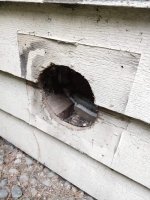ryanjg117
Member
- Joined
- May 18, 2015
- Messages
- 333
Removing an old, rather dilapidated metal tubular chimney off the back of our 1977 house. Along with it, removing an exhaust for an old pellet stove located in the basement. Pulled off the exterior surround for this exhaust today and noticed to my dismay they completely cut through a vertical stud to accommodate this tiny 4" exhaust:
[attachimg=1]
The roof trusses in this home are load bearing on the front and back of the house, meaning this is most likely a load bearing stud. There is some odd "settling" in the upstairs of the house, and this could certainly be a contributor to the issue.
I'm going to patch the house wrap and cedar siding but might as well try to at least put a block under this stud. Just want to get some ideas on how best to do that... Cut the existing stud flat, cut a block to insert, and use a framing nailer at an angle to make it whole?
[attachimg=1]
The roof trusses in this home are load bearing on the front and back of the house, meaning this is most likely a load bearing stud. There is some odd "settling" in the upstairs of the house, and this could certainly be a contributor to the issue.
I'm going to patch the house wrap and cedar siding but might as well try to at least put a block under this stud. Just want to get some ideas on how best to do that... Cut the existing stud flat, cut a block to insert, and use a framing nailer at an angle to make it whole?

